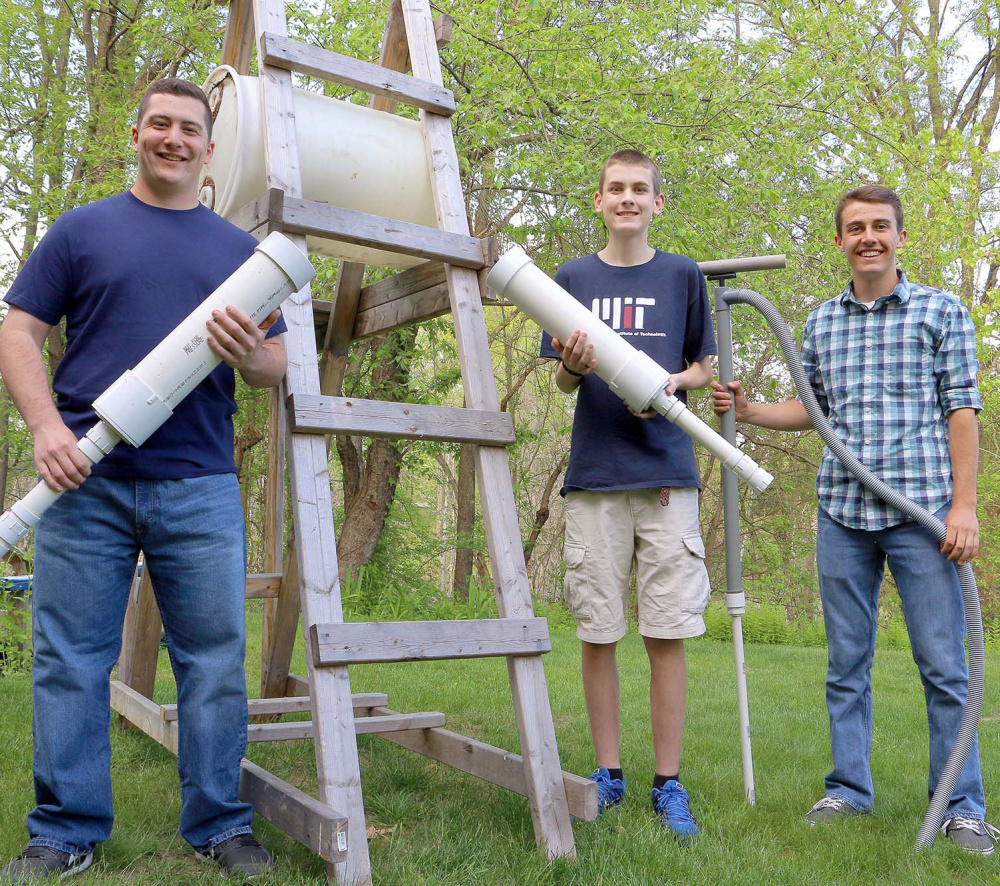LEOMINSTER, Mass. — What started as a science-fair project became much more for three Leominster High School students.
And to think it all started with a busted refrigerator filter.
For two years, Dylan Nadeau, Patrick Casey and Nick Valiton, all seniors less than a month from graduation, designed and built a non-electric water-filtration system for which they applied and received a provisional U.S. patent.
The original project was a filtration system using one polyvinyl chloride (PVC) pipe. But after years of experimentation, the final device stands 10 feet tall and uses gravity to filter water from a collection bin atop the wooden stand, through several filters down into a lower tank.
“We knew the project we had was simple, so we wanted to achieve a little more,” said Nadeau, 17.
The goal was clear: create something to present at the upcoming science fair. But the trio had big dreams from the start.
“We wanted to be able to solve a world problem,” said Valiton, 18. “At first, we thought about maybe tackling emissions, but decided against that.”
Casey, 17, said a broken water filter on his home refrigerator sparked the idea.
“The day we had this project assigned the filter in my fridge broke, so we smashed it to figure out how it works and kind of went from there,” he said.
What resulted was a collection of ideas and possibilities for their future project, although they wanted to make sure it was cost-effective and not driven by electricity.
The final product can hold 50 gallons of water, and filters 30 gallons overnight, or in about eight hours, Valiton said.
The whole system is estimated to cost $379, which could supply 30 people for four years before the filter has to be replaced at a cost of $159, Casey said. The filter would need to be replaced every 40,000 gallons.
Valiton’s proximity to the swamp, conveniently located in his backyard, helped the boys test their product on runoff water they lugged up the steep hill and pumped into the system.
Four filters containing activated carbon, which Casey referred to as “glorified charcoal,” and the process of kinetic degradation fluxion media remove large particles and heavy metals from the water passing through the cylindrical tube.
The students spoke eloquently and casually about the chemistry, physics, trigonometry and engineering involved.
So how did they figure it all out?
It was more than just Googling “help, I have calcium in my water,” Valiton said. It required research and trips to Home Depot, to the point at which workers in the plumbing department knew them by name, he said.
“It became a part-time job,” Valiton said.
They would get together for two hours after school to tweak and build the filtration system, he said.
For the amount of time and effort they put into the science-fair project, which ended up earning fourth place at the Worcester Regional Science Fair, they wanted to make sure no one else could steal their idea.
“As we were designing this and creating it, we want to make sure that what we were making was going to be ours. We found out the patent was the best way to maintain ownership of it,” Nadeau said. “Just in case we did want to continue with this, we wanted to make sure we were the sole owners of it.”
Although the patent expired in March, the group is considering going forward with the project despite beginning college in the fall.
While sitting in Valiton’s yard, Casey, who plans to study chemical engineering at UMass Lowell in the honors program, listed changes that could be made to the filtration project.
“I’m just kind of looking at it, thinking I want to work on it more,” he said, adding that he would like to be able to fold it up into a box, “which wouldn’t be hard now that I’m looking at it.”
Nadeau and Valiton are heading to Boston College to study computer science and law/political science, respectively.
Copy the Story LinkSend questions/comments to the editors.



Success. Please wait for the page to reload. If the page does not reload within 5 seconds, please refresh the page.
Enter your email and password to access comments.
Hi, to comment on stories you must . This profile is in addition to your subscription and website login.
Already have a commenting profile? .
Invalid username/password.
Please check your email to confirm and complete your registration.
Only subscribers are eligible to post comments. Please subscribe or login first for digital access. Here’s why.
Use the form below to reset your password. When you've submitted your account email, we will send an email with a reset code.